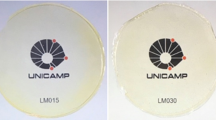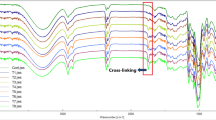Abstract
This research aimed to develop films based on chitosan/polyvinyl alcohol. These films were plasticized with glycerol, sunflower oil, and glucose. Mixtures of chitosan and polyvinyl alcohol were prepared at a ratio of 1:1 (w:w). Plasticizers were added at final concentrations of 20, 40, and 60% (chitosan weight/w). Physicochemical and mechanical properties of films were analyzed. The results indicated that moisture content, degree of swelling and solubility in the films increased due to glucose and glycerol hydrophilic components. However, this effect was not observed when the sunflower oil was used as plasticizer, due to the hydrophobic nature of this compound. The thickness increased as glycerol content raised, but it decreased when the sunflower oil was added. The films tensile stress and elasticity increased with the addition of glycerol but showed opposite results when the sunflower oil and glucose were added. Water vapor permeability increased proportionally with the glycerol concentration. Finally, the films biodegradability decreased when the plasticizers’ concentration increased. Functional groups, morphology and thermal degradation were assessed by FTIR, SEM and TGA, respectively. Morphological characterization of the laminated films with glycerol and glucose showed homogeneous surface and small aggregates. Films-plasticizer with Sunflower oil presented low-uniform surface. The results obtained from this research subjects that biodegradable films are suitable candidates to be used for food coating.









Similar content being viewed by others
Data availability
All the data presented in this research are the result of the experimental processes carried out.
References
Hajji S, Salem RBSB, Hamdi M, Jellouli K, Ayadi W, Nasri M, Boufi S (2017) Nanocomposite films based on chitosan–poly (vinyl alcohol) and silver nanoparticles with high antibacterial and antioxidant activities. Proc Safety Environ Protection 111:112–121
Kanikireddy V, Murali Mohan Y, Varaprasad K, Nagireddy N, Sakey R, Sudhakar Naidu N, Mohana Raju K (2011) Fabrication of curcumin encapsulated chitosan-PVA silver nanocomposite films for improved antimicrobial activity. J Biomater Nanobiotechnol 2(1):55–64
Srinivasa P, Ramesh M, Tharanathan R (2006) Effect of plasticizers and fatty acids on mechanical and permeability. Food Hydrocoll 21(1):1113–1122
Arvanitoyannis I, Kolokuris I, Nakayama A, Yamamoto N, Aiba S-I (1997) Physico-chemical studies of chitosan-poly(vinyl alcohol) blends plasticized with sorbitol and sucrose. Carbohyd Polym 34:9–19
Kang Sofla MS, Mortazavi S, Seyfi J (2020) Preparation and characterization of polyvinyl alcohol/chitosan blends plasticized and compatibilized by glycerol/polyethylene glycol. Carbohyd Polym 232:115784
Bano I, Arshad M, Yasin T, Ghauri MA (2019) Preparation, characterization and evaluation of glycerol plasticized chitosan/PVA blends for burn wounds. Int J Biol Macromol 124:155–162
Koosha M, Hamedi S (2019) Intelligent Chitosan/PVA nanocomposite films containing black carrot anthocyanin and bentonite nanoclays with improved mechanical, thermal and antibacterial properties. Prog Org Coat 127:338–347
Xiancai J, Linxi H, Yulai Z (2016) The effect of glycerol on properties of chitosan/poly(vinyl alcohol) films with AlCl3·6H2O aqueous solution as the solvent for chitosan. Carbohyd Polym 135:191–198
Cazón P, Velázquez G, Vázquez M (2019) Characterization of bacterial cellulose films combined with chitosan and polyvinyl alcohol: evaluation of mechanical and barrier properties. Carbohyd Polym 216:72–95
Hezma AM, Rajeh A, Mannaa MA (2019) An insight into the effect of zinc oxide nanoparticles on the structural, thermal, mechanical properties and antimicrobial activity of Cs/PVA composite. Colloids Surf Physicochem Eng Aspects. https://doi.org/10.1016/j.colsurfa.2019.123821
Stefani R, Pereira V, Queiroz I (2015) Active chitosan/PVA films with anthocyanins from Brassica oleraceae (Red Cabbage) as Time-Temperature Indicators for application in intelligent food packaging. Food Hydrocolloids 43:180–188
Hosseini MH, Razavi SH, Mousavi MA (2009) Antimicrobial, physical and mechanical properties of chitosan-based films incorporated with thyme, clove and cinnamon essential oils. J Food Process Preserv 33(6):727–743
Kumaran MK (1998) Interlaboratory comparison of the ASTM standard test methods for water vapor transmission of materials (E 96–95). J Test Eval 26:83–88
Aydinli M, Tutas M (2000) Water sorption and water vapour permeability roperties of polysaccharide (Locust Bean Gum) based edible films. LWT Food Sci Technol 33(1):63–67
Debeaufort F, Martin Polo M, Voilley A (1993) Polarity homogeneity and structure affect water vapor permeability of model edible films. Food Sci 58(2):426–429
Medina Jaramillo C, Gutiérrez T, Goyanes S, Bernal C, Famá L (2016) Biodegradability and plasticizing effect of yerba mate extract on cassava starch edible films. J Polym Environ 151(1):150–159
Huang J, Qin J, Zhang P, Chen X, You X, Zhang F, Zuo B, Yao M (2020) Facile preparation of a strong chitosan-silk biocomposite film. Carbohyd Polym. https://doi.org/10.1016/j.carbpol.2019.115515
Pérez Mateos M, Montero P, Gómez Guillén MC (2009) Formulation and stability of biodegradable films made from cod gelatin and sunflower oil blends. Food Hydrocoll 23:53–61
Tripathi S, Mehrotra G, Dutta P (2009) Physicochemical and bioactivity of cross-linked chitosan–PVA film for food packaging applications. Int J Biol Macromol 45:372–376
Solikhin A, Hadi YS, Massijaya MY, Nikmatin S, Suzuki S, Kojima Y, Kobori H (2018) Properties of Poly(Vinyl Alcohol)/Chitosan nanocomposite films reinforced with oil palm empty fruit bunch amorphous lignocellulose nanofibers. J Polym Environ 26(8):3316–3333
de Farias BS, Grundmann DDR, Rizzi FZ, Martins NSS, Junior TRSAC, de Almeida Pinto LA (2019) Production of low molecular weight chitosan by acid and oxidative pathways: effect on physicochemical properties. Food Res Int 123:88–94
Batista K, Yamashita F, Marques F, Fernandes F (2013) Lipase entrapment in PVA/Chitosan biodegradable film for reactor coatings. Mater Sci Eng C 33:1696–1701
Soloman P, Rejini V, Agil A (2016) Preparation of chitosan-polyvinyl alcohol blends and studies on thermal and mechanical properties. Procedia Technol 24:741–748
Affes S, Aranaz I, Acosta N, Heras Á, Nasri M, Maalej H (2021) Chitosan derivative-based films as pH-sensitive drug delivery systems with enhanced antioxidant and antibacterial properties. Int J Biol Macromol 182:730–742
Ventura Aguilar RI, Díaz Galindo EP, Bautista Baños S, Mendoza Acevedo S, Munguía Cervantes JE, Correa Pacheco ZN, Bosquez Molina E (2021) Monitoring the infection process of Rhizopus stolonifer in strawberry fruits during storage using chitosan/polyvinyl alcohol/polyvinylpyrrolidone based films and plant extracts. Int J Biol Macromol 182:583–594
Liu Y, Yuan Y, Duan S, Li C, Hu B, Liu A, Wu D, Cui H, Lin L, He J, Wu W (2020) Preparation and characterization of chitosan films with three types of molecular weight for food packaging. Int J Biol Macromol 155:249–259
Saenz-Mendoza AI, Zamudio-Flores PB, García-Anaya MC, Velasco CR, Acosta-Muñiz CH, de Jesús Ornelas-Paz J, Salgado-Delgado R (2020) Characterization of insect chitosan films from Tenebrio molitor and Brachystola magna and its comparison with commercial chitosan of different molecular weights. Int J Biol Macromol 160:953–963
Azadbakht E, Maghsoudlou Y, Khomir M (2018) Development and structural characterization of chitosan films containing Eucalyptus globulus essential oil: potential as an antimicrobial carrier for packaging of sliced sausage. Food Packag Shelf Life 17:65–72
Souza V, Monte M, Pinto L (2011) Preparation of biopolymer film from chitosan modified with lipid fraction. Int J Food Sci Technol 46(4):1856–1862
Llanquileo L, Gamboa A, Abugoch L, Tapia C (2021) Manufacture of β-chitin nano- and microparticles from jumbo squid pen (Dosidicus gigas) and evaluation of their effect on mechanical properties and water vapour permeability of polyvinyl alcohol/chitosan films. J Food Eng 290:110230
Abdullah ZW, Dong Y (2019) Biodegradable and Water Resistant Poly(vinyl) Alcohol (PVA)/Starch (ST)/Glycerol (GL)/Halloysite Nanotube (HNT) Nanocomposite Films for Sustainable Food Packaging. Frontiers Mater 6(58):17
Giteru SG, Ali MA, Oey I (2019) Solvent strength and biopolymer blending effects on physicochemical properties of zein-chitosan-polyvinyl alcohol composite films. Food Hydrocolloids 87:270–286
Sithole M, Choonara Y, Du Toit L, Kumar P, Pillay V (2016) A review of semi-synthetic biopolymer complexes: modified polysaccharide nano-carriers for enhancement of oral drug bioavailability. Pharmaceut Develop Technol 22(2):283–295
Slagman S, Zuilhof H, Franssen MCR (2019) Laccase‐mediated grafting on biopolymers and synthetic polymers: a critical review. ChemBioChem 19(14):288–311
Laskar N, Kumar U (2019) Plastics and microplastics: a threat to environment. Environ Technol Innov. https://doi.org/10.1016/j.eti.2019.100352
Sánchez González L, Cháfer M, González Martínez C (2010) Physical properties of edible chitosan films containing bergamot essential oil and their inhibitory action on Penicillium italicum. Carbohydrate Polym 82(2):277–283
Mansur H, Sadahira C, Souza A, Mansur A (2007) FTIR spectroscopy characterization of poly (vinyl alcohol) hydrogel with different hydrolysis degree and chemically crosslinked with glutaraldehyde. Mater Sci Eng. https://doi.org/10.1016/j.msec.2007.10.088
Haghighi H, Kameni Leugoue S, Pfeifer F, Wilhelm Siesler H, Licciardello F, Fava P, Pulvirenti A (2020) Development of antimicrobial films based on chitosan-polyvinyl alcohol blend enriched with ethyl lauroyl arginate (LAE) for food packaging applications. Food Hydrocoll 100:105419
Ardekani Zadeh AH, Fakhreddin Hos S (2019) Electrospun essential oil-doped chitosan/poly(ε-caprolactone) hybrid nanofibrous mats for antimicrobial food biopackaging exploits. Carbohyd Polym 223:115108
Sun Y, Liu Z, Zhang L, Wang X, Li L (2020) Effects of plasticizer type and concentration on rheological, physico-mechanical and structural properties of chitosan/zein film. Int J Biol Macromol 143:334–340
Ghaderi J, Hosseini SF, Keyvani N, Gómez-Guillén MC (2019) Polymer blending effects on the physicochemical and structural features of the chitosan/poly (vinyl alcohol)/fish gelatin ternary biodegradable films. Food Hydrocoll 95:122–132
Morales A, Andrés MÁ, Labidi J, Gullón P (2019) UV–vis protective poly(vinyl alcohol)/bio-oil innovative films. Ind Crops Prod 131:281–292
Cao N, Yang X, Fu Y (2009) Effects of various plasticizers on mechanical and water vapor barrier properties of gelatin films. Food Hydrocoll 23(3):729–735
Cazón P, Velázquez G, Vázquez M (2020) Regenerated cellulose films combined with glycerol and polyvinyl alcohol: effect of moisture content on the physical properties. Food Hydrocoll 103:105657
Erdem BG, Dıblan S, Kaya S (2019) Development and structural assessment of whey protein isolate/sunflower seed oil biocomposite film. Food Bioprod Process 118:270–280
Gao W, Liu P, Li X, Qiu L, Hou H, Cui B (2019) The co-plasticization effects of glycerol and small molecular sugars on starch-based nanocomposite films prepared by extrusion blowing. Int J Biol Macromol 133:1175–1181
Saberi B, Chockchaisawasdee S, Golding J, Scarlett C, Stathopoulos C (2017) Physical and mechanical properties of a new edible film made of pea starch and guar gum as affected by glycols, sugars and polyols. Int J Biol Macromol 104(Part A):345–359
Acknowledgements
The authors thank the University of Cartagena, for the financial support of this work in the Eighth call for funding of research projects for research groups categorized on the Scienti de Colciencias platform, 2017, Colombia. The Department of Materials Physics-Electronic Nanomaterials Physics Research Group of the Faculty of Physical Sciences of the Complutense University of Madrid (UCM), Spain.
Funding
This investigation was supported and funded by the University of Cartagena, Colombia.
Author information
Authors and Affiliations
Corresponding author
Ethics declarations
Conflicts and interests
The authors declared that there is no conflicts of interest.
Additional information
Publisher's Note
Springer Nature remains neutral with regard to jurisdictional claims in published maps and institutional affiliations.
Rights and permissions
About this article
Cite this article
Hernández Berrío, Y.D., Realpe Jiménez, Á. & De Ávila Montiel, G. Effect of glycerol, sunflower oil, and glucose on the physico-chemical and mechanical properties of chitosan/polyvinyl alcohol-based films. Polym. Bull. 79, 6389–6407 (2022). https://doi.org/10.1007/s00289-021-03803-w
Received:
Revised:
Accepted:
Published:
Issue Date:
DOI: https://doi.org/10.1007/s00289-021-03803-w




